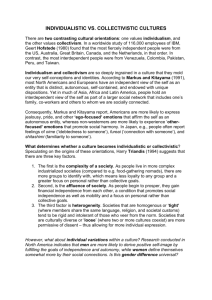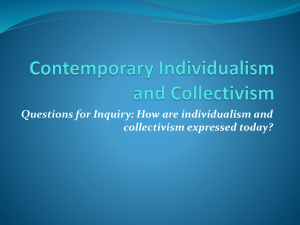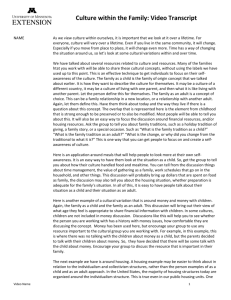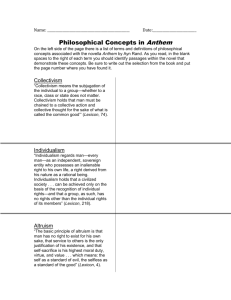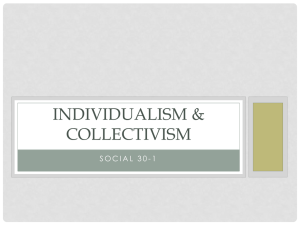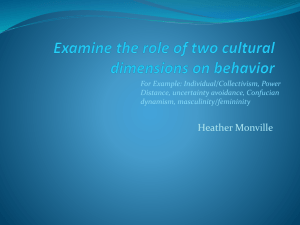respondent cultural orientations and survey participation
advertisement
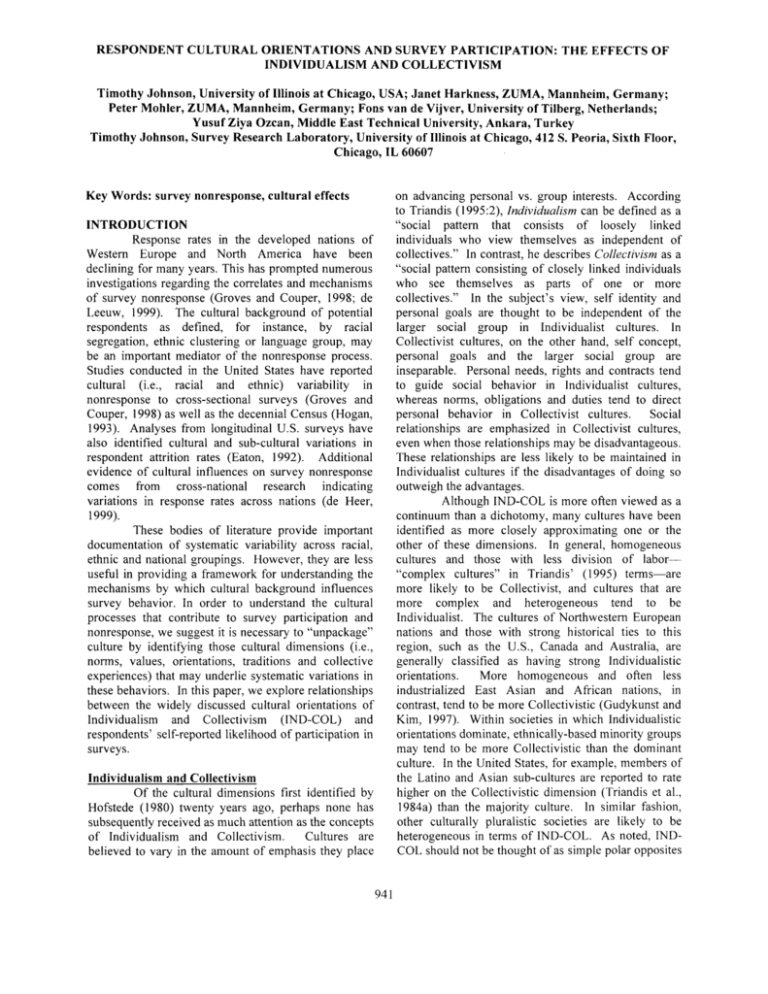
RESPONDENT CULTURAL O R I E N T A T I O N S AND SURVEY PARTICIPATION: THE EFFECTS OF INDIVIDUALISM AND COLLECTIVISM Timothy Johnson, University of Illinois at Chicago, USA; Janet Harkness, ZUMA, Mannheim, Germany; Peter Mohler, ZUMA, Mannheim, Germany; Fons van de Vijver, University of Tilberg, Netherlands; Yusuf Ziya Ozcan, Middle East Technical University, Ankara, Turkey Timothy Johnson, Survey Research Laboratory, University of Illinois at Chicago, 412 S. Peoria, Sixth Floor, Chicago, IL 60607 Key Words: survey nonresponse, cultural effects on advancing personal vs. group interests. According to Triandis (1995:2), Individualism can be defined as a "social pattern that consists of loosely linked individuals who view themselves as independent of collectives." In contrast, he describes Collectivism as a "social pattern consisting of closely linked individuals who see themselves as parts of one or more collectives." In the subject's view, self identity and personal goals are thought to be independent of the larger social group in Individualist cultures. In Collectivist cultures, on the other hand, self concept, personal goals and the larger social group are inseparable. Personal needs, rights and contracts tend to guide social behavior in Individualist cultures, whereas norms, obligations and duties tend to direct personal behavior in Collectivist cultures. Social relationships are emphasized in Collectivist cultures, even when those relationships may be disadvantageous. These relationships are less likely to be maintained in Individualist cultures if the disadvantages of doing so outweigh the advantages. Although IND-COL is more often viewed as a continuum than a dichotomy, many cultures have been identified as more closely approximating one or the other of these dimensions. In general, homogeneous cultures and those with less division of labor-"complex cultures" in Triandis' ( 1 9 9 5 ) t e r m s - - a r e more likely to be Collectivist, and cultures that are more complex and heterogeneous tend to be Individualist. The cultures of Northwestern European nations and those with strong historical ties to this region, such as the U.S., Canada and Australia, are generally classified as having strong Individualistic orientations. More homogeneous and often less industrialized East Asian and African nations, in contrast, tend to be more Collectivistic (Gudykunst and Kim, 1997). Within societies in which Individualistic orientations dominate, ethnically-based minority groups may tend to be more Collectivistic than the dominant culture. In the United States, for example, members of the Latino and Asian sub-cultures are reported to rate higher on the Collectivistic dimension (Triandis et al., 1984a) than the majority culture. In similar fashion, other culturally pluralistic societies are likely to be heterogeneous in terms of IND-COL. As noted, INDCOL should not be thought of as simple polar opposites INTRODUCTION Response rates in the developed nations of Western Europe and North America have been declining for many years. This has prompted numerous investigations regarding the correlates and mechanisms of survey nonresponse (Groves and Couper, 1998; de Leeuw, 1999). The cultural background of potential respondents as defined, for instance, by racial segregation, ethnic clustering or language group, may be an important mediator of the nonresponse process. Studies conducted in the United States have reported cultural (i.e., racial and ethnic) variability in nonresponse to cross-sectional surveys (Groves and Couper, 1998) as well as the decennial Census (Hogan, 1993). Analyses from longitudinal U.S. surveys have also identified cultural and sub-cultural variations in respondent attrition rates (Eaton, 1992). Additional evidence of cultural influences on survey nonresponse comes from cross-national research indicating variations in response rates across nations (de Heer, 1999). These bodies of literature provide important documentation of systematic variability across racial, ethnic and national groupings. However, they are less useful in providing a framework for understanding the mechanisms by which cultural background influences survey behavior. In order to understand the cultural processes that contribute to survey participation and nonresponse, we suggest it is necessary to "unpackage" culture by identifying those cultural dimensions (i.e., norms, values, orientations, traditions and collective experiences) that may underlie systematic variations in these behaviors. In this paper, we explore relationships between the widely discussed cultural orientations of Individualism and Collectivism (IND-COL) and respondents' self-reported likelihood of participation in surveys. Individualism and Collectivism Of the cultural dimensions first identified by Hofstede (1980) twenty years ago, perhaps none has subsequently received as much attention as the concepts of Individualism and Collectivism. Cultures are believed to vary in the amount of emphasis they place 941 collection in each country was conducted during either 1999 or 2000. The survey questionnaire used items developed in U.S. English that were subsequently translated into German and Turkish by bilingual survey researchers experienced in questionnaire design. The translations were checked by a translation assessment expert using committee procedures. Some items which did not translate well were excluded from the final data file. Each version of this instrument is available from the respective authors. The U.S. and Turkish respondents were given course credits for participating in the survey, while the German respondents were contacted in a large student dining facility and paid DM 15 (sufficient for a pizza and a beverage) for participating. of one another. According to Schwartz (1990), some values, such as wisdom, may underlie or serve both perspectives, suggesting that individuals and cultures may integrate elements of each of these seemingly exclusive orientations. In technical terms this means that we cannot expect the two dimensions to be independent (orthogonal) from each other. Respondents might score similarly on both dimensions. Implications for Survey Nonresponse An important distinction between Individualist and Collectivist orientations that may have implications for survey nonresponse is the importance given to cooperating with others. The literature reviewed above suggests that in the survey context, persons with Collectivist orientations should be more willing to comply with survey requests because of the relatively greater emphasis placed on cooperation by Collectivism. In particular, an orientation that emphasizes personal sacrifice in the name of the greater social good would seem to be consistent with enhanced survey participation. In contrast, the greater emphasis on personal goals of an Individualist orientation could be expected to result in less compliance with requests to participate in surveys. These typically provide no direct material rewards to the individual and may be viewed as burdensome. Research also suggests that Collectivism is associated with conformity, which may be associated with survey participation. A meta-analysis of Asch conformity experiments reported that individuals from Collectivist cultures were more likely to exhibit conforming behavior (Bond and Smith, 1996). These findings are consistent with earlier observations that in some Collectivistic societies, there is cultural emphasis on positive social interactions that may encourage compliance in a variety of contexts (Triandis et al., 1984b; Jones, 1983). Certain aspects of IND-COL may in fact be related to such well-known concepts as social desirability, courtesy bias, acquiescence bias and response styles. There is currently, however, little direct evidence available with which to evaluate the potential effects of IND-COL on survey-related behavior. The purpose of this paper is to explore this issue by presenting an initial investigation of the relationship between IND-COL orientations and survey participation within and across three unique cultural groups. Measures The survey instrument contained several measures of interest for this analysis. Three items in the questionnaire served as indicators of our dependent variable: survey nonresponse. These included questions asking students how likely or unlikely they would be to agree to complete mail questionnaires and to participate in telephone and face-to-face interviews. Each item was measured on a 4-point Likert scale ranging from "definitely would not" participate to "definitely would" participate. Higher scores for each item represented greater willingness to participate in the survey. The exact wording of all survey items are available from the first author. Instruments reported by Triandis (1995) were employed to develop two measures each of IND-COL. The first of these included 32 Likert-type statements using a 7-point agreement scale that ranged from "strongly agree" to "strongly disagree." Sixteen of these items were taken as indicators of an Individualistic social orientation, the remaining 16 items as indicators of Collectivism. Half of the items in each set were designed to represent the vertical and horizontal forms of Individualism and Collectivism respectively (Triandis and Gelfand, 1998). Representative vertical and horizontal Individualism items included: "It annoys me when other people perform better than I do" and "One should live one's life independently of others." Examples of vertical and horizontal Collectivism items include: "I usually sacrifice my self-interest for the benefit of my group" and "It is important to me to maintain harmony within my group," respectively. Higher scores on each measure indicated higher levels of Individualistic and Collectivistic orientations, respectively. The second set of measures of these constructs consisted of a set of 31 vignettes. Two of the 31 items were deleted because of comparability concerns, leaving a total of 29 vignettes for analysis. Four possible courses of action were presented with each METHODS Data Sources The data for this study come from selfadministered questionnaires completed by samples of students recruited at three metropolitan universities in the United States (n=83 in Chicago), Germany (n-89 in Mannheim) and Turkey (n-100 in Ankara). Data 942 vignette, and respondents were asked to rank these in terms of how appropriate they considered each course of action to be. For each vignette, Triandis (1995) defined two of the four potential courses of action a priori as Individualistic and two as Collectivistic (one vertical and one horizontal). Four indices were constructed for each respondent, based on the number of vignettes which they ranked as their first or second choice the vertical Individualistic, horizontal Individualistic, the vertical Collectivistic or horizontal Collectivistic courses of action. Each index was weighted such that the number of first choices received twice the weight of the number of second choices. Analyses of the four vignette sets were less successful. Factorial structures were very dissimilar. Large numbers of items had to be deleted in order to obtain scales with adequate levels of factorial agreement. Of the 29 items in each set, between 8090% had to be eliminated to achieve equivalence. The phi coefficients for these truncated instrument comparisons are also shown in Table 1. Cronbach's alpha reliability coefficients were subsequently calculated for each measure within each sample. Alpha coefficients for the survey participation measures ranged from 0.50 (in the German sample) to 0.66 (in the Turkish sample); for the U.S. sample, the survey participation measure had an alpha of 0.59. We consider these to be acceptable for the purposes of this exploratory research. The scale measures of IND-COL were also found to be acceptable. These 12 coefficients ranged from 0.56-0.84 with a median value of 0.67. The set of coefficients for the vignette measures, however, did not suggest good reliability. The values for these measures ranged between 0.36-0.68 with a median value of 0.57. Since large numbers of vignette items had to be dropped in order to achieve structural equivalence and the resulting measures, as a group, demonstrated poor reliability, the vignette indicators of IND-COL were not included in the analyses described below. Our findings raise serious questions about the internal consistency of these instruments and their use in crosscultural research. Construct Equivalence and Reliability We examined the cross-group construct equivalence of each of the measures described above using procedures recommended by Van de Vijver and Leung (1997). Specifically, exploratory factor analyses were performed at the national level to determine if there was a unifactorial structure within each sample. This was followed by an assessment of factorial agreement between each pair of samples using Tucker's phi coefficients. Phi coefficients of 0.90 and greater are considered to be evidence of factorial similarity (Ten Berge, 1986). Where factorial similarity was not adequate, factor loadings were examined, dissimilar items were deleted, additional factor analyses were conducted, and factorial similarity was again examined via Tucker's phi. This process was repeated until either acceptable construct equivalence could be established or it became clear that the scale in question was structurally incongruent across samples. Using these procedures, a strong unifactorial structure was identified for the three-item scale measuring survey participation within each of the three samples. A single factor accounted for between 5160% of the variance associated with this set of items within each sample. Tucker's phi comparisons for each pair of countries were very high (0.98 and above), indicating good structural equivalence (see Table 1). Assessments of the IND-COL Likert-type items also generally suggested factorial agreement across groups. Three of the four scales were found to have acceptable agreement. Factor analyses of the fourth scale, horizontal Individualism, also suggested good cross-group agreement. Tucker's phi coefficients, however, were less than optimal. A single item that was a good indicator in the U.S. (with a loading of 0.58) but was a weaker indicator in the two other countries (with loadings less than 0.20) was then deleted. A reanalysis indicated that deletion of the one item led to acceptable agreement across samples. Tucker's phi coefficients for each sample pair for each IND-COL scale are presented in Table 1. Data Analyses Preliminary analyses involved descriptive comparisons of variables across the German, Turkish and U.S. samples and within sample correlations. Covariance Structure Analysis was next employed to assess the associations between the four IND-COL scales and the survey participation indicators (Bollen, 1989). These associations were modeled simultaneously for each of the three samples using multi-group analyses. For these analyses, MIMIC ("Multiple Indicators and Multiple Causes") models were employed in which a set of observed IND-COL scales were employed as "predictors" of the latent construct of survey participation (J6reskog and Sorbom, 1989). The three self-report measures of survey participation described above were employed as indicators of this latent variable. Four observed measures were employed as independent variables. These included the vertical and horizontal versions of the Individualism and Collectivism Likert-type batteries. Preliminary analyses suggested difficulty constructing independent latent measures of Individualism and Collectivism across groups. A MIMIC model was then employed because it enabled us to take advantage of the information available from 943 each of these measures. Nested models were estimated in which measurement and structural parameters were successively constrained to be equal, in order to determine the extent to which associations between IND-COL and survey participation were similar across samples. Models were estimated via maximum likelihood (LISREL version 8). RESULTS Differences in survey nonresponse intentions between the national samples are presented in Table 2. The trend across each of the measures strongly suggests greater resistance to survey participation in the U.S. sample. Least resistance was found in the Turkish sample for each measure, with the German sample consistently demonstrating intermediate levels of resistance. Each difference was significant as assessed by a chi-square test. Notably, a majority of U.S. respondents indicated that they either "definitely" or "probably" would not agree to participate in any form of survey. Also of note is the finding that no U.S. respondents indicated that they would definitely comply with a request to complete a mail questionnaire. A majority of the German sample indicated a willingness to participate in a mail survey but not a telephone or face-to-face interview. Majorities of the Turkish sample expressed a willingness to take part in a mail survey or a face-to-face interview but not a telephone interview. Initial model fitting of these data using multiple group structural equation modeling revealed associations between two of the IND-COL measures and a latent measure of survey participation. Consequently, a final model was estimated that assessed the effects of these two indicators (vertical Individualism and horizontal Collectivism). Analyses of nested models indicated that model fit was not significantly worsened by constraining measurement, structural and residual error (i.e., the psi parameter) coefficients to be equal across groups. This final model is presented in Table 3. It suggests that all three indicators of survey participation were strongly associated with the latent measure of that construct. In addition, the vertical Individualism scale was found to be negatively associated with survey participation. In contrast, horizontal Collectivism was positively associated with the participation construct. Although the overall model fit was good, it accounted for only five percent of the variance in survey participation. DISCUSSION The findings of this analysis provide preliminary evidence consistent with the notion that decisions to participate in social surveys are in part mediated by elements of respondent culture (Johnson, O'Rourke, Burris and Owens, in-press). Earlier 944 research, however, focused on social identity indicators, such as race/ethnicity and nation of residence. Such research is less able to provide insights regarding the cultural processes that might account for nonresponse differences across social groups. In the present study, IND-COL orientations were found to be independently associated with self-reported willingness to participate in social surveys in samples of German, Turkish and U.S. university students. These findings are consistent with the expectation that persons with Individualist orientations are less likely and persons with Collectivist orientations are more likely to be willing to comply with survey requests. Of course, this study has several limitations that must be considered. Perhaps most importantly, the samples examined are university students, who are probably not representative of the cultures being examined. Consequently, it is not possible to draw firm generalizations from these data. We nonetheless contend that the samples used are appropriate for conducting initial assessments of methods and measures. Similar sampling strategies have been successfully used in numerous other investigations of survey methodology (Ji, Schwarz and Nisbett, 2000; Schwarz et al., 1991). Indeed, this work has identified important measurement problems that need to be addressed in future studies. The reliability of several of the IND-COL measures, for example, were very low and were not subsequently analyzed. Additional efforts will be necessary before these constructs can be measured with acceptable levels of precision and replicability. Further, it is not clear that the measure of survey nonresponse employed in this study is an adequate proxy indicator of actual survey-related behavior. Although self-reported measures of survey participation intentions have been recently employed in the research literature (Klesges et al., 1999; McNutt and Lee, 2000), other recent research has indicated that intentions reported to interviewers may not match later behavior (Jansen and Hak, 1999). Nonetheless, this research suggests that cultural orientations may account for differences in survey nonresponse behavior. As such, we believe that an aggressive program designed to systematically explore these potential mechanisms should be initiated. Having conducted this initial work, we are aware of the multiple methodological challenges that must be overcome as part of any such effort. As the problem of survey nonresponse continues to grow, however, researchers need to learn as much as possible about potential pathways by which social context influences survey participation. Successfully confronting barriers to survey participation will require a clear understanding of how sociocultural processes influence the behavior of survey respondents. The decomposition of culture, as this paper demonstrates, is one new approach that may help survey researchers begin to address this ongoing challenge. Eltinge, and R. J. A. Little (Eds.), Survey Nonresponse. New York: John Wiley & Sons. Jones, E. L. (1983). The courtesy bias in South-East Asian surveys. Pp. 253-260 in M. Bulmer and D. P. Warwick (Eds.), Social Research in Developing Countries. London: UCL Press. REFERENCES Bollen, K. A. (1989). Structural Equations with Latent Variables. New York: John Wiley & Sons. J6reskog, K. G., and Sorbom, D. (1989). LISREL 7: A Guide to the Program and Applications, 2 nd ed. Chicago: SPSS, Inc. Bond, R., and Smith, P. B. (1996). Culture and conformity: A meta-analysis of studies using Asch's (1952b, 1956) line judgment task. Psychological Bulletin 119:111-137. Klesges, R. C., Williamson, J. E., Somes, G. W., Talcott, G. W., Lando, H. A., and Haddock, C. K. (1999). A population comparison of participants and nonparticipants in a health survey. American Journal of Public Health 89:1228-1231. de Heer, W. (1999). International response trends: Results of an international survey. Journal of Official Statistics 15: 129-142. de Leeuw, E. (1999). Special issue on survey nonresponse. Journal of Official Statistics 15: 127350. McNutt, L. A., and Lee, R. (2000). Intimate partner violence prevalence estimation using telephone surveys: Understanding the effect of nonresponse bias. American Journal of Epidemiology 152: 438441. Eaton, W. W., Anthony, J. C., Tepper, S., and Dryman, A. (1992). Psychopathology and attrition in the Epidemiologic Catchment Area Surveys. American Journal of Epidemiology 135:1051-1059. Schwartz, S. H. (1990). Individualism-collectivism: Critique and proposed refinements. Journal of Cross-Cultural Psychology 21:139-157. Groves, R. M., and Couper, M. P. (1998). Nonresponse in Household Interview Surveys. New York: John Wiley & Sons. Schwarz, N., Knauper, B., Hippler, H.J., NoelleNeumann, E. and Clark, L. (1991). Rating scales: Numeric values may change the meaning of scale labels. Public Opinion Quarterly 55: 570-582. Gudykunst, W. B. (1997). Cultural variability in communication: An introduction. Communication Research 24: 327-348. Ten Berge, J.M.F. (1986). Rotatie naar perfecte congruentie en de multipele groep methode. Nederlands Tijdshrift voor de Psychologie 41:218225. Gudykunst, W. B., and Kim, Y. Y. (1997). Communicating with Strangers." An Approach to Intercultural Communication, 3rd ed. New York: McGraw-Hill. Triandis, H. C. (1995). Individualism and Collectivism. Boulder, CO: Westview Press. Hofstede, G. (1980). Culture's Consequences. International Differences in Work-Related Values. Beverly Hills, CA: Sage. Yriandis, H.C. and Gelfand, M.J. (1998) Converging measurement of horizontal and vertical individualism and collectivism. Journal of Personality and Social Psychology 74:118-128. Hogan, H. (1993). The 1990 post-enumeration survey: Operations and results. Journal of the American Statistical Association 88:1047-1060. Triandis, H. C., Marin, G., Hui, C. H., Lisansky, J., and Ottati, V. (1984a). Role perceptions of Hispanic young adults. Journal of Personality and Social Psychology, 47: 1363-1374. Jansen, H., and Hak, T. (1999). Nonresponse to mail surveys in a lower/class urban area. A two-stage exploration of access failure and refusal. Bulletin de Methodologie Sociologique 62:5-27. Triandis, HC, Marin, G, Lisansky, J and Betancourt, H (1984b) Simpatia as a cultural script for Hispanics. Journal of Personality and Social Psychology 47: 1363-1375. Ji, L.J., Schwarz, N. and Nisbett, R.E. (2000) Culture, autobiographical memory, and behavioral frequency reports: Measurement issues in crosscultural studies. Personality and Social Psychology Bulletin 26: 585-593. Van de Vijver, F., and Leung, K. (1997). Methods and Data Analysis for Cross-Cultural Research. Thousand Oaks, CA: Sage. Johnson, T. P., O'Rourke, D., Burris, J., and Owens, L. (In-press). Respondent culture and survey nonresponse. In R. Groves, D. A. Dillman, J. L. 945 Table 2 Survey Nonresponse Variable Comparisons Between German, U.S. and Turkish Samples" Percent, (n) Table 1 Tucker's Phi Coefficients of Factorial Agreement Across Samples for Study Measures Measure Survey Participation Vertical Individualism Scale Horizontal Individualism Scale Vertical Collectivism Scale Horizontal Collectivism Scale Vertical Individualism Vignettes Horizontal Individualism Vignettes Vertical Collectivism Vignettes Horizontal Collectivism Vignettes No. items Germany vs. U.S. U.S. VS. VS. Turkey Turkey 3 0.99 0.99 0.98 8 0.93 0.96 0.94 0.94 0.95 0.95 8 German Sample Germany 0.95 0.94 0.96 0.97 10.96 0.97 7 0.95 0.98 0.92 7 0.92 0.95 0.94 0.97 0.99 0.92 0.97 0.95 0.94 Sample Turkish Sample 17.7 (14) 45.6 (36) 36.7(29) 0.0 (0) 29.3 (27) 19.6 (18) 26.1 (24) 25.0 (23) 32.9 35.4 29.1 2.5 38.0 (35) 17.4 (16) 32.6 (30) 12.0 (11) U.S. Participate in: A. Mail Survey*** -definitely would not 16.9 (15) -probably would not 22.5 (20) -probably would 43.8 (39) 'definitely would 16.9 (15) , B. Telephone Interview* -definitely would not 22.5 (20) -probably would not 34.8 (31) -probably would 34.8 (31) -definitely would 7.9 (7) C. Face-to-face Interview*** -definitely would not 25.8 (23) -probably would not 34.8 (31) -probably would 28.1 (25) -definitely would 11.2 (10) *p < .05, ***p < .001 (26) (28) (23) (2) 31.6(25) 9.9 (9) 35.4 (28) 13.2 (12) 30.8 (24) 36.3 (33) 2.5 (2) 40.7 (37) Table 3 Multi-Group Structural Equation Model for German, Turkish and U.S. Samples Unstandardized Coefficients (SE) I. Measurement Model: Survey Nonresponse a --mail survey --phone survey --face-to-face survey II. Structural Model a --vertical individualism scale --horizontal collectivism scale 1.00 b 1.44 (0.33)*** 1.25 (0.28)*** -0.01 (0.00)+ 0.01 (0.01)* III. Model Fit --chi-square (dO 26.23 (22) ns --GFI 0.99 --RMSEA 0.046 a all estimated parameters constrained to be equal across sample groups b fixed parameter +p < .10, *p < .05, ***p < .001 946
